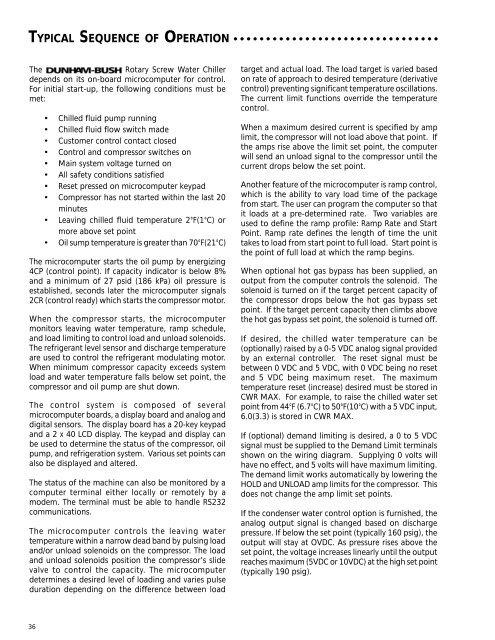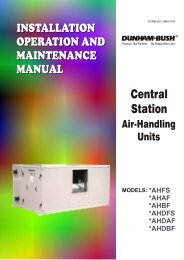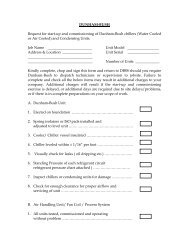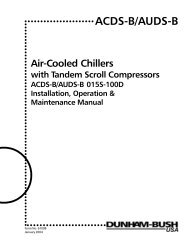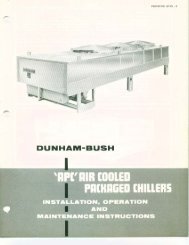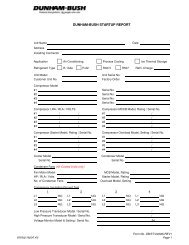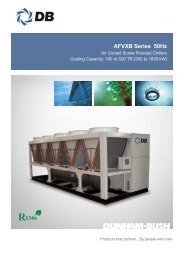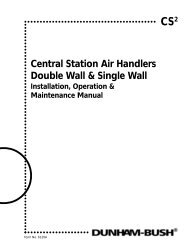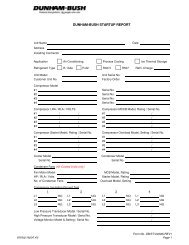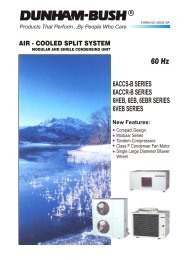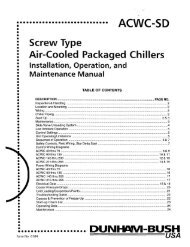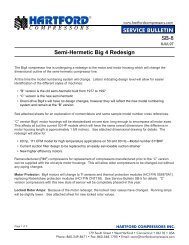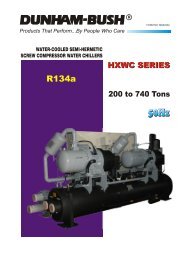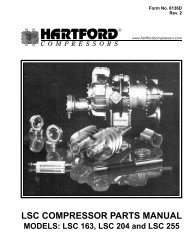IPCX Chillers - Dunham-Bush Americas
IPCX Chillers - Dunham-Bush Americas
IPCX Chillers - Dunham-Bush Americas
Create successful ePaper yourself
Turn your PDF publications into a flip-book with our unique Google optimized e-Paper software.
TYPICAL SEQUENCE OF OPERATION○ ○ ○ ○ ○ ○ ○ ○ ○ ○ ○ ○ ○ ○ ○ ○ ○ ○ ○ ○ ○ ○ ○ ○ ○ ○ ○ ○ ○ ○ ○ ○TheRotary Screw Water Chillerdepends on its on-board microcomputer for control.For initial start-up, the following conditions must bemet:• Chilled fluid pump running• Chilled fluid flow switch made• Customer control contact closed• Control and compressor switches on• Main system voltage turned on• All safety conditions satisfied• Reset pressed on microcomputer keypad• Compressor has not started within the last 20minutes• Leaving chilled fluid temperature 2°F(1°C) ormore above set point• Oil sump temperature is greater than 70°F(21°C)The microcomputer starts the oil pump by energizing4CP (control point). If capacity indicator is below 8%and a minimum of 27 psid (186 kPa) oil pressure isestablished, seconds later the microcomputer signals2CR (control ready) which starts the compressor motor.When the compressor starts, the microcomputermonitors leaving water temperature, ramp schedule,and load limiting to control load and unload solenoids.The refrigerant level sensor and discharge temperatureare used to control the refrigerant modulating motor.When minimum compressor capacity exceeds systemload and water temperature falls below set point, thecompressor and oil pump are shut down.The control system is composed of severalmicrocomputer boards, a display board and analog anddigital sensors. The display board has a 20-key keypadand a 2 x 40 LCD display. The keypad and display canbe used to determine the status of the compressor, oilpump, and refrigeration system. Various set points canalso be displayed and altered.The status of the machine can also be monitored by acomputer terminal either locally or remotely by amodem. The terminal must be able to handle RS232communications.The microcomputer controls the leaving watertemperature within a narrow dead band by pulsing loadand/or unload solenoids on the compressor. The loadand unload solenoids position the compressor’s slidevalve to control the capacity. The microcomputerdetermines a desired level of loading and varies pulseduration depending on the difference between loadtarget and actual load. The load target is varied basedon rate of approach to desired temperature (derivativecontrol) preventing significant temperature oscillations.The current limit functions override the temperaturecontrol.When a maximum desired current is specified by amplimit, the compressor will not load above that point. Ifthe amps rise above the limit set point, the computerwill send an unload signal to the compressor until thecurrent drops below the set point.Another feature of the microcomputer is ramp control,which is the ability to vary load time of the packagefrom start. The user can program the computer so thatit loads at a pre-determined rate. Two variables areused to define the ramp profile: Ramp Rate and StartPoint. Ramp rate defines the length of time the unittakes to load from start point to full load. Start point isthe point of full load at which the ramp begins.When optional hot gas bypass has been supplied, anoutput from the computer controls the solenoid. Thesolenoid is turned on if the target percent capacity ofthe compressor drops below the hot gas bypass setpoint. If the target percent capacity then climbs abovethe hot gas bypass set point, the solenoid is turned off.If desired, the chilled water temperature can be(optionally) raised by a 0-5 VDC analog signal providedby an external controller. The reset signal must bebetween 0 VDC and 5 VDC, with 0 VDC being no resetand 5 VDC being maximum reset. The maximumtemperature reset (increase) desired must be stored inCWR MAX. For example, to raise the chilled water setpoint from 44°F (6.7°C) to 50°F(10°C) with a 5 VDC input,6.0(3.3) is stored in CWR MAX.If (optional) demand limiting is desired, a 0 to 5 VDCsignal must be supplied to the Demand Limit terminalsshown on the wiring diagram. Supplying 0 volts willhave no effect, and 5 volts will have maximum limiting.The demand limit works automatically by lowering theHOLD and UNLOAD amp limits for the compressor. Thisdoes not change the amp limit set points.If the condenser water control option is furnished, theanalog output signal is changed based on dischargepressure. If below the set point (typically 160 psig), theoutput will stay at OVDC. As pressure rises above theset point, the voltage increases linearly until the outputreaches maximum (5VDC or 10VDC) at the high set point(typically 190 psig).36


